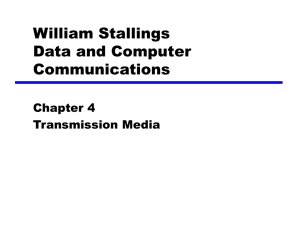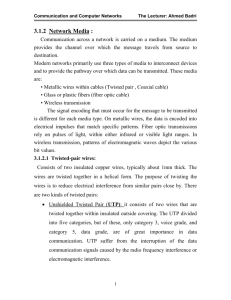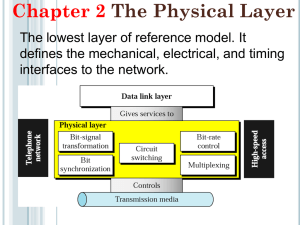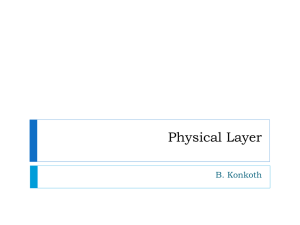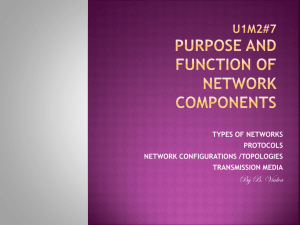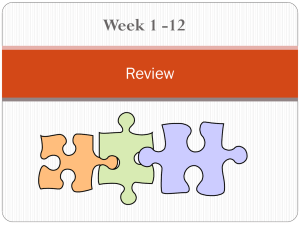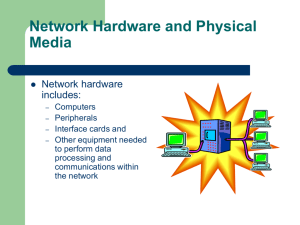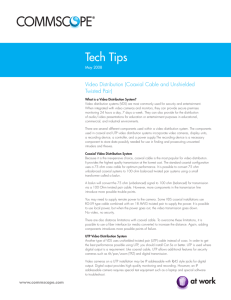Introduction - Eastern Illinois University
advertisement
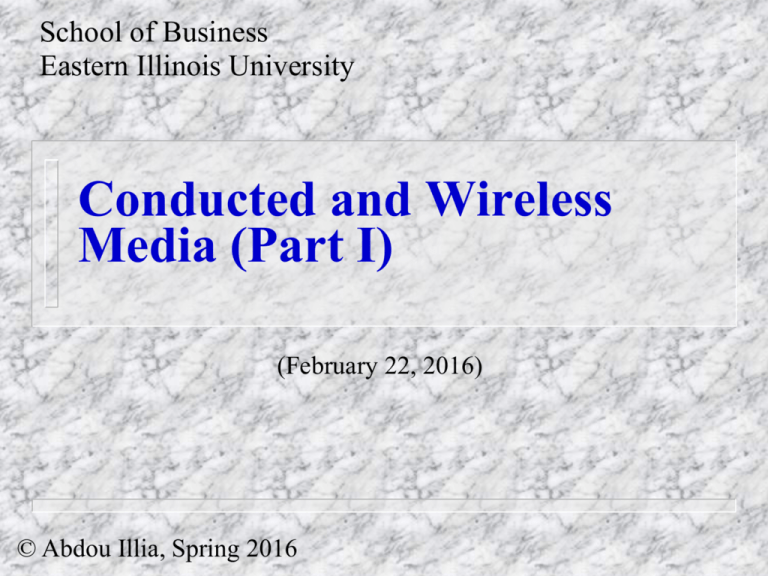
School of Business Eastern Illinois University Conducted and Wireless Media (Part I) (February 22, 2016) © Abdou Illia, Spring 2016 Learning Objectives Outline characteristics of conducted media Select conducted media in LAN design 2 Major categories of Media Conducted Media – Physically connect network devices Wireless Media – Use electromagnetic waves/radiation 3 Conducted Media Twisted Pair cable Coaxial cable Optical Fiber cable 4 Twisted Pair wire 5 Shielded Twisted Pair (STP) Versus Unshielded Twisted Pair (UTP) Typically 2 or more Twisted pair wires & different standards for different applications http://en.wikipedia.org/wiki/Twisted_pair Twisted Pair wire 2 Q: Are Shielded Twisted Pairs (STP) affected by interference ? 6 7 Coaxial cable A single wire wrapped in a foam (or plastic) insulation surrounded by a braided metal shield, then covered in a plastic jacket Cable can be thick or thin Provides for wide range of frequencies 8 Coaxial cable Two major coaxial technologies: Baseband Coaxial tech. Uses digital signaling Broadband Coaxial tech. Transmits anal./digital signals One channel of digital data ~1 kilometer w/o repeater Thin coaxial cable Multiple channels of data ~ 4 kilometer w/o repeater – – Typically used for digital data transmission in Ethernet LANs Typically used for baseband transmission Thick coaxial cable – – Typically for broadband transmission Typically used for video transmission Less noise/interference compared to twisted pairs 9 Coaxial cable Coaxial cable standards: Type① Ohm rating② RG-11 75 ohm RG-58 50 ohm Use Used in 10Base5 Ethernet (known as Thick Ethernet) Used in 10Base2 Ethernet RG (Radio Guide) specifies characteristics like wire thickness, insulation thickness, electrical properties, etc. Ohm is the measure of resistance within the medium 10Base5 Speed: 10 Mbps Signal type: Baseband transmission Distance: 500 meters Fiber Optic 10 Fiber Optic 11 A thin glass cable approximately a little thicker than a human hair Two concentric layers termed Core and Cladding Cladding Core Common types: – – 62.5/125 microns 50/125 microns 12 Fiber Optic Photo diode (LED or LD) Source Destination Photo diode (light/laser source) at the transmitting end – Fiber optic cable Photo receptor (LED or LD) Generate light/laser and modulate it to represent binary data received from Source Photo receptor (optic sensor) at the receiving end – Receive the light/laser and convert it into digital signal Fiber Optic Many advantages over Twisted pair and Coaxial cable – – – – – 13 Speed No significant noise No interference Less signal attenuation, i.e. longer distance Low-power transceivers could be used (less electric consumption) Typical use in Businesses Conducted Media 14 15 Case study The following figure shows a common situation in LANs. Remember : – – Using Category 5 UTP, the maximum segment length is 100 meters. A wall jack is a passive device that does not regenerate signals Cat 5-UTP Crossover cable 16 Case study Cat 5-UTP Crossover cable What kind of problem there will be if the distance between the Workstation and the Hub is more than 100 meters? What solution can be applied ? If the cable that connects the workstation and the hub passes through a noisy environment (Heating or cooling mechanical room) what action could be taken to prevent interference? 17 Case study Cat 5-UTP Crossover cable If the needed data rate is higher than 100 Mbps, what are the possible solutions? Summary Questions 18 What does cross talk interference mean ? How can crosstalk interference be reduced ? If transmission wires are placed side by side, electromagnetic radiation is emitted by one wire and picked up by the other. Twisting pair of wire reduce crosstalk interference. What categories of twisted pair are usually used in LANs ? Categories 3, 4, 5, 6, 7, 8 What are the advantages and disadvantages of STP compared to UTP ? Advantage: better level of isolation from interference. Disadvantage: cost What is the main difference between baseband coaxial cable and broadband coaxial cable ? Baseband carries digital signals with a single channel. Broadband carries analog or digital signals with multiple channels. What are the advantages of Optical fiber compared twisted pair and coaxial cable ? Speed, No significant noise, No interference, Long distance Can you transmit video signal over twisted pair wire ? Explain You can. Noise used to be a limitating factor, but it’s no longer the case. 19 Baseband signaling Single transmission channel Only one bit at a time .....1110011 1101110 1100001 1010100 1010100 Uses TDM (Time Division Multiplexing) Voltage 1 1 1 0 1010100 1110010 1100001 1101110 1110011 1100110 1100101 1110010 0100000 0100100 0110001 0110010 0110000 0110000 0101110 0110000 0110000 0 Time T r a n s f e r space $ 1 2 0 0 . 0 0 Broadband signaling Multiple transmission channels Multiple bits at a time 20 1010100 T 1110010 r 1100001 a 1101110 n 1110011 s 1100110 f 1100101 e 1110010 r 1111111 0111111 1100100 0001000 1001000 0101110 0010101 Uses FDM (Frequency Division Multiplexing)
